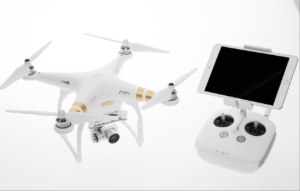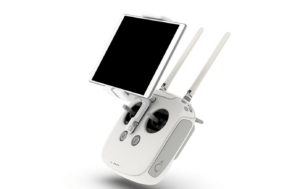 We speculated, we did the preview, we gathered the hearsay and now we finally have had a chance to fly. Here is the DroneLife DJI Phantom 3 review.
We speculated, we did the preview, we gathered the hearsay and now we finally have had a chance to fly. Here is the DroneLife DJI Phantom 3 review.
As you probably know, there are two versions of the Phantom 3, the Advanced and the Professional. The two drones are identical in almost every way except for the forward indicator stickers (silver for the Advanced, gold for the Professional) and the fact that the Professional is capable of 4k image capture while the Advanced shoots in 1080p.
For this review we will be discussing the Professional model.
Let’s get one this clear: the DJI Phantom 3 is not a toy. It’s deceptive because the controller and the drone itself are elegant and simple; they have precisely as many buttons as they need. But when you pair the rig with the new DJI Pilot app (now connected via a physical cord instead of WiFi!) you are confronted with so many features and adjustable settings, it can get a little overwhelming.
Obviously, a lot of people who buy a Phantom 3 will ignore most of these features just like majority of iPhone users have ignored the “Stocks” app on their phones since always. So, in the interest of keeping the post a review of the drone itself, we will try to avoid talking about the app and saving it for another post.
To the Phantom!
What’s in the box?
1 Phantom 3 Professional drone
1 Remote Controller
8 propellers
1 intelligent flight battery (not compatible with any of the older generation Phantoms)
1 battery charger
1 16 GB micro SD card
4 Landing Pads (for the Phantom’s legs)
1 gimbal clamp (USE THIS when you are not flying. I can’t stress that enough)
4 vibration absorbers
1 propeller wrench
1 Micro-USB cable
The Controller
Like the last generation of Phantom 2 Vision + controllers, the Phantom 3 controller resembles that of DJI’s Inspire 1. It sports two antennae that give it a range of about 2 km and dials on its shoulders to control the angle of the camera and light saturation, respectively.
 On the right shoulder next to the wheel that controls gimbal angle there is a button for recording video and a switch that toggles flight mode (more on this below). Next to the light saturation wheel on the left is the button for taking still photos and a button for playing back any recorded media. This last button only works when the controller is connected to a smartphone or tablet.
On the right shoulder next to the wheel that controls gimbal angle there is a button for recording video and a switch that toggles flight mode (more on this below). Next to the light saturation wheel on the left is the button for taking still photos and a button for playing back any recorded media. This last button only works when the controller is connected to a smartphone or tablet.
As mentioned above, the new controller requires a cable to connect to your phone or tablet for FPV viewing. Technologically, this may seem like a step back from the Phantom 2 which connected via WiFi, but the image display quality (720p) and delay on your phone/tablet is so much better (to say nothing about how many steps a physical connection takes out of setting up a wireless connection) than the previous method, you will wonder why DJI ever bothered with WiFi in the first place.
The front of the controller features a collapsible mount for your phone/tablet, LED lights that indicate battery life, and two big buttons.
The first button is the power button which, creatively, turns the system on and off.
The second button is the return to home button. Unlike the return to home functionality which was not clearly indicated in the previous generation of Phantoms, this safety feature is prominently displayed for when (not if, when) you get in trouble.
It is important to note that when you hit the return to home button, the Phantom will ascend to 100 feet and fly to the GPS coordinates it recognizes as ‘home’ (conveniently displayed -and edited- on a little map in the bottom left corner of the app) before descending to the ground. So, if you took off in your garage and flew out the doors, don’t expect the Phantom to land itself back in your garage.
The Camera
This is the part where I usually take a moment to discuss the camera specs and how they stack up against other drone cameras on the market:
The Phantom 3 Professional’s 4k camera is the best camera of any ready-to-fly consumer drone on the market.
Moving on.
How Does It Fly?
There is a reason when you hear a news report about some idiot crashing his drone, the drone is usually a DJI Phantom. The Phantom is easily the most popular drone because it packs seriously advanced technology into a relatively inexpensive package, it requires basically no assembly, and it’s easy to fly.
The reason the DJI Phantom 3 deserves to be praised is because it improves upon everything that made the Phantom 2 and Phantom 2 Vision + so impressive.
The downward facing Vision Positioning system, which uses ultrasound and image processing technology to ‘see’ directly below the drone, is the single most impressive feature of the Phantom 3.
When the Phantom 3 is just hovering, it is locked in position as if it were supported by a tether. Even on a breezy day and up 100+ feet, we could not perceive any drift to speak of. The only way the Phantom moved was when we told it to.
The Phantom 3 can be flown in three different flight modes, labeled P, A, and F, which can be selected by the switch on the right shoulder of the controller. We wouldn’t have known what these letters meant unless we dove into the manual and it turns out knowing how the different modes work is pretty useful so here is a quick overview:
P mode stands for Positioning mode and it’s the default setting for flying your Phantom because it uses the GPS and the Vision Positioning system. P mode actually has three sub-settings; P-GPS uses both the GPS and Vision positioning at the same time, P-OPTI kicks in when GPS signal is low so the Phantom uses only the Vision Positioning to maintain its location, and P-ATTI which uses the Phantom’s barometer to maintain altitude but not GPS position.
Incidentally, A-mode functions the same as P-ATTI with the added bonus of still being able to return to home.
F mode engages the intelligent orientation control feature which simply means the controls will be communicated relative to the direction the Phantom was pointing when it took off. So, if you launch your Phantom 3 in F mode and push the control stick forward the drone will always fly forward regardless of the direction the front of the drone is facing.
It all works as advertised and it’s really up to you which mode you prefer.
The new brushless motor and ESCs make for a powerful combination. The Phantom 3 is fast and extremely agile – it doesn’t ‘skid’ nearly as much as other consumer drones or previous generations of Phantoms.
Finally, the aforementioned 720p live stream also really impressed us, especially at range. Short of actually using specialized goggles, the Phantom 3 provides the best way to reliably fly a drone using first person view.
One Thing, Though
There was one deficiency that came to our attention and it was the fact that the picture we were taking didn’t come out level relative to the horizon.
The new camera does away with the fisheye effect of previous generations but, whether it was the gimbal or the drone, the horizon was typically slanted. Of course, this is nothing a little photoshop can’t fix, but there was no easy way to re-level your gimbal. We are still looking into it…
The DJI Phantom 3: A DroneLife Review
The DJI Phantom 3 is the smoothest flight experience you can have with a consumer drone. The tech is so advanced and easy to use, it’s easy to overlook how complex of a machine the Phantom really is. And isn’t that the mark of technological achievement – when all the processes work so smoothly, you don’t even think about them?
[cms id=”35944″]
The fact that DJI kept the price at $1295, the exact price they were selling the Vision + a year ago, is really the icing on the cake. When a new iteration of a gadget comes out, whether it’s a new phone, a game console or TV, you expect the price to be a little higher than the last generation. To keep the price the same is unheard of.
So, if you are considering a Phantom 3, we encourage you to pull the trigger. There is a lot of fuss being made about drones these days and the Phantom 3 is a great example of what the fuss is about and why it is so important.
Do you love your Phantom 3? Hate it? Did we miss some key features? Let us know in the comments!
Alan is serial entrepreneur, active angel investor, and a drone enthusiast. He co-founded DRONELIFE.com to address the emerging commercial market for drones and drone technology. Prior to DRONELIFE.com, Alan co-founded Where.com, ThinkingScreen Media, and Nurse.com. Recently, Alan has co-founded Crowditz.com, a leader in Equity Crowdfunding Data, Analytics, and Insights. Alan can be reached at alan(at)dronelife.com








On the horizon not being level. There is an adjustment in the gimbal settings that lets you correct the angle. However, I found on my drone, that one of the little white boots attaching the gimbal assembly had come out of the hole on the gimbal. Once I put the boot back through the hole, the camera has been 100% level. You may also need to do an imu alignment, which clears many issues the crop up.
I love the P3Pro. I just wish there was more training info. Where can I find out how to use the autonomous features like Waypoint, follow, circle?? I purchased Autopilot software, but it will take a long time to learn all of features of this software.( Even it leaves some gaps as to how it interfaces with DJI Go. )Tell me were to learn. I spend hours online watching videos and looking for more info.
In the mean time, I have tons of fun flying up and down and back and forth shooting stunning video of the mountains around my home. I am ready to move forward with professional shots.
Awesome gear.. Amazing the amount of serious avionics and electronics, that’s made available to the consumer market.. Well done to DJI! Keep it coming.
Is wifi the only way to connect to a dji phantom 3 standard remote? No hardwire?
The user mannual is very poor.
What do you know about the cracking in the arms?
We have heard some stories but have not run into this issue yet. Did you lose and arm?
Two minor additions:
* The Phantom 3 comes with eight propellers, not four. (You get a set of spares as well.)
* The wheel on your right hand is used for setting exposure. Pressing this wheel like a button switches between ISO and shutter time.